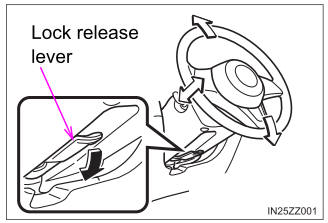Toyota Yaris: Steering Wheel / Steering Wheel Adjustment
To change the angle or length of the steering wheel:
- Stop the vehicle, and then pull down the lock release lever under the steering column.
- Tilt the steering wheel and/or
adjust the steering column
length to the desired positions,
then push the lever up to lock
the column.

- Attempt to push the steering wheel up and down to make sure it’s locked before driving.
WARNING
Make sure that the steering wheel is locked firmly in place
If it is difficult to raise the lever, lightly move the steering wheel forward and back to pull up the lever.
Never adjust the steering wheel while the vehicle is moving
Adjusting the steering wheel while the vehicle is moving is dangerous. Moving it can very easily cause the driver to abruptly turn to the left or right. This can lead to loss of control or an accident.
After adjusting the steering wheel position, make sure it is securely locked by trying to move it up and down
Driving with the steering wheel not securely locked in position is dangerous. If the steering wheel moves unexpectedly while driving, you could lose control of the steering resulting in an accident.
 Heated Steering Wheel (if equipped)
Heated Steering Wheel (if equipped)
The grips on the left and right of
the steering wheel can be warmed
up.
The ignition must be switched ON.
Press the switch to turn on the heated steering wheel...
Other information:
Toyota Yaris XP210 (2020-2026) Reapir and Service Manual: Disposal
DISPOSAL CAUTION / NOTICE / HINT CAUTION: Before performing pre-disposal deployment of any SRS part, review and closely follow all applicable environmental and hazardous material regulations. Pre-disposal deployment may be considered hazardous material treatment...
Toyota Yaris XP210 (2020-2026) Reapir and Service Manual: Inspection
INSPECTION PROCEDURE 1. INSPECT ENGINE COOLANT TEMPERATURE SENSOR CAUTION: Do not put your hands into the water that has been heated for the inspection. Touching the heated water could result in burns. (a) Measure the resistance according to the value(s) in the table below...
Categories
- Manuals Home
- Toyota Yaris Owners Manual
- Toyota Yaris Service Manual
- How to use USB mode
- Fuse Panel Description
- Auto Lock/Unlock Function
- New on site
- Most important about car
Front Seat Belt Pretensioners
The front seat belt pretensioners are designed to deploy in moderate or severe frontal, near frontal collisions.
In addition, the pretensioners operate when a side collision or a rollover accident is detected. The pretensioners operate differently depending on what types of air bags are equipped. For more details about the seat belt pretensioner operation, refer to the SRS Air Bag Deployment Criteria.

